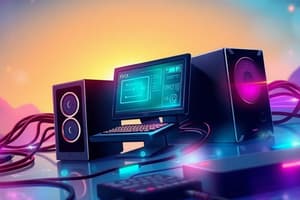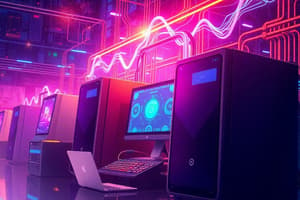Podcast
Questions and Answers
Which of the following correctly identifies the primary function of peripheral devices in a personal computer?
Which of the following correctly identifies the primary function of peripheral devices in a personal computer?
- Perform input and output functions while being user-accessible (correct)
- Provide internal storage and processing capabilities
- House the CPU and power supply to enhance efficiency
- Facilitate communication between components within the motherboard
What is the role of the motherboard in a personal computer?
What is the role of the motherboard in a personal computer?
- To connect all internal components and manage communication between them (correct)
- To house all external connections for user peripherals
- To provide an all-in-one design eliminating the need for additional components
- To serve as a cooling unit for the CPU and memory
Which component would typically not be a part of a standard PC's internal assembly?
Which component would typically not be a part of a standard PC's internal assembly?
- Central Processing Unit (CPU)
- Fixed Disk
- Peripheral Input Device (correct)
- Power Supply Unit
What is a distinguishing feature of an all-in-one personal computer?
What is a distinguishing feature of an all-in-one personal computer?
Why is it important for a technician to understand both modern and legacy connection interfaces?
Why is it important for a technician to understand both modern and legacy connection interfaces?
What is the primary purpose of a cutout aligned with the motherboard’s input/output ports in a PC case?
What is the primary purpose of a cutout aligned with the motherboard’s input/output ports in a PC case?
Which component is responsible for preventing improper insertion of connectors into ports?
Which component is responsible for preventing improper insertion of connectors into ports?
What potential issues can arise from uncovered adapter card slots in a PC case?
What potential issues can arise from uncovered adapter card slots in a PC case?
Which statement is true regarding the front panel of a PC case?
Which statement is true regarding the front panel of a PC case?
What does a hardware port in a computer primarily serve as?
What does a hardware port in a computer primarily serve as?
Study Notes
CompTIA A+ Technician Roles
- Install and configure personal computer (PC) hardware, attracting many to IT support careers.
- Set up desktop computers and help users select appropriate system configurations and peripheral devices.
- Connect peripheral devices via correct cables and connectors, ensuring efficient communication with the motherboard.
- Distinguish between modern and legacy connection interfaces to support various environments.
Components of a Personal Computer
- Personal computers comprise user-handled peripheral devices and dangerous internal components.
- Peripheral devices include input devices (keyboard, mouse), output devices (monitor, speakers), and external storage.
- Internal components housed in the system case/chassis are the motherboard, central processing unit (CPU), system memory, adapter cards, fixed disks, and power supply unit (PSU).
- Tower form factor cases are oriented vertically, while all-in-one units contain components within the monitor case.
PC Maintenance
- Understand how to open the desktop computer case; tower cases have removable side covers secured by screws or clips.
- Always consult system documentation for proper maintenance steps.
- The front panel provides access to removable media drives, power switches, and status LEDs.
- The rear panel grants access to PSU sockets and I/O ports for peripheral device connection.
Peripheral Device Connectivity
- Input/output (I/O) ports connect devices via peripheral cables; some ports are device-specific, while others are versatile.
- External ports are located on the front or rear of the PC and may be situated on the motherboard or as expansion cards.
Interfaces, Ports, and Connectors
- Hardware ports serve as external connection points for bus interfaces, enabling data transfer to and from devices.
- Connectors are components of peripheral cables that fit into corresponding ports, utilizing designs that prevent incorrect insertion.
- USB ports and various connector types exemplify this versatility in connecting devices like portable hard drives.
Data Measurement and Transfer Units
- Binary data storage and transfer are fundamental in computing; binary digits (bits) represent values of one or zero.
- Storage is often indicated in bytes, where one byte equals eight bits.
- Transfer rates are critical metrics, expressed in units per second, influencing the performance of data transmission between devices.
Studying That Suits You
Use AI to generate personalized quizzes and flashcards to suit your learning preferences.
Description
Test your knowledge on the roles of a CompTIA A+ technician and the essential components of a personal computer. This quiz covers hardware installation, system configuration, and an overview of both internal and peripheral devices. Assess your understanding of PC setups and connections!




